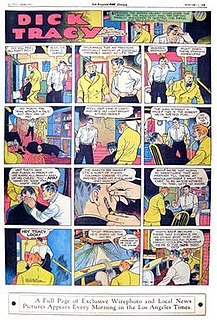
Dick Tracy is an American comic strip featuring Dick Tracy, a tough and intelligent police detective created by Chester Gould. It made its debut on Sunday, October 4, 1931 in the Detroit Mirror, and it was distributed by the Chicago Tribune New York News Syndicate. Gould wrote and drew the strip until 1972, and various artists and writers have continued it. Dick Tracy has also been the hero in a number of films, including Dick Tracy in which Warren Beatty played the lead in 1990. Tom De Haven praised Gould's Dick Tracy as an "outrageously funny American Gothic", while Brian Walker described it as a "ghoulishly entertaining creation" which had "gripping stories filled with violence and pathos".
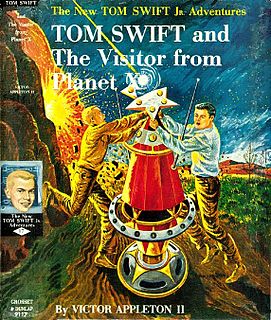
Tom Swift Jr. is the central character in a series of 33 science fiction adventure novels for male adolescents, following in the tradition of the earlier Tom Swift ("Senior") novels. The series was titled The New Tom Swift Jr. Adventures. Unlike the Nancy Drew and Hardy Boys titles that were also products of the prolific Stratemeyer Syndicate, the original Tom Swift stories were not rewritten in the 1950s to modernize them. It was decided that the protagonist of the new series would be the son of the earlier Tom Swift and his wife, Mary Nestor Swift; the original hero continued as a series regular, as did his pal Ned Newton. The covers were created by illustrator J. Graham Kaye. Covers in the later half of the series were mostly by Charles Brey. A total of 33 volumes were eventually published.
Disney comics are comic books and comic strips featuring characters created by the Walt Disney Company, including Mickey Mouse, Donald Duck and Uncle Scrooge.
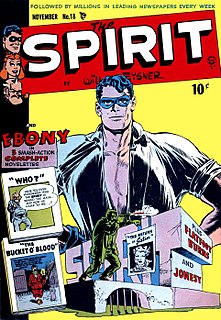
The Spirit is a fictional masked crimefighter created by cartoonist Will Eisner. He first appeared June 2, 1940, as the main feature of a 16-page, tabloid-sized, newsprint comic book insert distributed in the Sunday edition of Register and Tribune Syndicate newspapers; it was ultimately carried by 20 Sunday newspapers, with a combined circulation of five million copies during the 1940s. "The Spirit Section", as the insert was popularly known, continued until October 5, 1952. It generally included two other four-page strips, plus filler material. Eisner was the editor, but also wrote and drew most entries—after the first few months, he had the uncredited assistance of writer Jules Feiffer and artists Jack Cole and Wally Wood, though Eisner's singular vision for the strip was a unifying factor.

Alexander Toth was an American cartoonist active from the 1940s through the 1980s. Toth's work began in the American comic book industry, but he is also known for his animation designs for Hanna-Barbera throughout the 1960s and 1970s. His work included Super Friends, Space Ghost, Sealab 2020, The Herculoids and Birdman. Toth's work has been resurrected in the late-night, adult-themed spin-offs on Cartoon Network: Space Ghost Coast to Coast, Sealab 2021 and Harvey Birdman, Attorney at Law.
Michael "Mick" Anglo was a British comic book writer, editor and artist, as well as an author. He is best known for creating the superhero Marvelman, later known as Miracleman.

Denis Gifford was a British writer, broadcaster, journalist, comic artist and historian of film, comics, television and radio. In his lengthy career, he wrote and drew for British comics; wrote more than fifty books on the creators, performers, characters and history of popular media; devised, compiled and contributed to popular programmes for radio and television; and directed several short films. Gifford was also a major comics collector, owning what was perhaps the largest collection of British comics in the world.
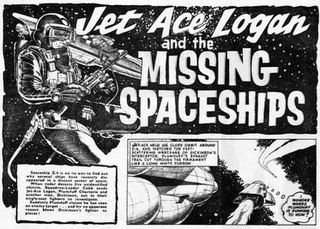
Jet-Ace Logan was a British comic strip that appeared in The Comet (1956–1959) and Tiger (1959–1968), issues of Thriller Picture Library, plus the 1969 and 1972 Tiger Annuals. It was originally drawn by John Gillat, and writers contributing scripts included David Motton, Kenneth Bulmer, and Frank S. Pepper; other artists illustrated the character's adventures, including Brian Lewis, Ron Turner, Francisco Solano López, Kurt Caesar and Geoff Campion.
Bloodhound Mystery is a novel series published by the London firm of T.V. Boardman Ltd. between 1948 and 1967. There were two sub-series, American Bloodhound Mysteries and British Bloodhound Mysteries. Both series saw the original hardcover editions of many important works of detective/crime fiction. British artist Denis McLoughlin served as art director for Boardman Books and provided many of the dust jacket illustrations.
Colin McLoughlin is a British freelance writer. With his brother Denis McLoughlin, Colin created the comic book characters Swift Morgan, Roy Carson, Buffalo Bill, Sam English, and other comic book characters in the 1940s-1950s for the London publishing house TV. Boardman, Ltd..
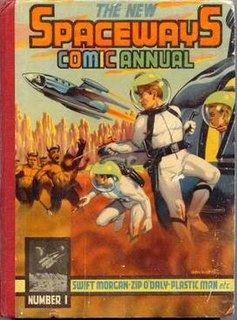
The New Spaceways Comic Annual was published in 1954 by London's Boardman Books under their Popular Press imprint. The Book is about 10.75 x 7.75 inches. hardcover, printed boards, 158 pages. Contents are a combination of comic book and illustrated text stories. Illustrated in four color and black and white. Denis McLoughlin, creative director for the series, based most of the spacemen, rockets, flying saucers, space creatures, robots, etc. on the toys then carried by Woolworth's. Woolworth's were the primary distributor of the Boardman annuals in the United Kingdom, Australia, New Zealand, Canada, and all over the former British Empire.

War Picture Library was a British 64-page Pocket library war comic magazine title published by Amalgamated Press/Fleetway for 2103 issues. Each issue featured a complete story, beginning on 1 September 1958 with "Fight Back to Dunkirk" and finishing 26 years later with "Wings of the Fleet". The Editor was Ted Bensberg. Assistant Editors included Geoff Kemp and Brian Smith. Other editorial staff included Pat Brookman, Terence Magee, Clive Ranger, Tony Power and Clive McGee. Art Editor was Mike Jones and Art Assistant was his brother Dave Jones. Other Art Assistants at various times were Roy McAdorey, Geoff Berwick, Bill Reid, John Fearnley.
Avon Publications is one of the top most publishers of romance fiction. At Avon's initial stages, it was an American paperback book and comic book publisher. The shift in content occurred in the early 1970s with multiple Avon romance titles reaching and maintaining spots in bestseller lists, demonstrating the market and potential profits in romance publication. As of 2010, Avon is an imprint of HarperCollins.
The Eastern Color Printing Company was a company that published comic books, beginning in 1933. At first it was only newspaper comic strip reprints, but later on original material was published. Eastern Color Printing was incorporated in 1928, and soon became successful by printing color newspaper sections for several New England and New York papers. Eastern is most notable for its production of Funnies on Parade and Famous Funnies, two publications that gave birth to the American comic book industry.
Lancer Books was a publisher of paperback books founded by Irwin Stein and Walter Zacharius that operated from 1961 through 1973. While it published stories of a number of genres, it was noted most for its science fiction and fantasy, particularly its series of Robert E. Howard's Conan the Barbarian tales, the first publication of many in paperback format. It published the controversial novel Candy by Terry Southern and Mason Hoffenberg, and Ted Mark's ribald series The Man from O.R.G.Y. Lancer paperbacks had a distinctive appearance, many bearing mauve or green page edging.
Roy Carson was a British hard-boiled detective created in 1948 by Denis McLoughlin and his brother Colin and first published by Boardman Books in their series of rotogravure comic books (1948–1954). Roy, with his plucky girl companion Silk, faced all manner of underworld adventures with an odd combination of American and British elements. Boardman Books also used Roy Carson in text stories published in their children's annuals in the 1950s. In the late-1950s and early 1960s, Roy Carson stories were reprinted in a number of British albums and annuals. In 1999, the comic fanzine Best of British #1 reprinted Roy Carson and the Old Master, originally published in 1953.
Ronald Turner was a British illustrator and comic book artist.
Richard E. Jennings was a comic book artist who lived and worked in the United Kingdom.








